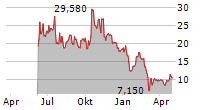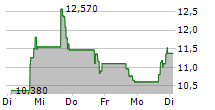
A 30% reduction in long episodes was shown to be associated with a 50% or greater reduction in clinical seizures in a post-hoc analysis, validating the biomarker for proof-of-concept studies
Change in long episode frequency is the primary endpoint for Rapport's ongoing Phase 2a proof-of-concept trial in focal epilepsy, with topline data expected in mid-2025
Data from additional studies, including preclinical seizure data and Phase 1 pharmacokinetic and safety trial results, support the potential of RAP-219 as a transformational treatment for patients with focal epilepsy
BOSTON and LOS ANGELES, Dec. 06, 2024 (GLOBE NEWSWIRE) -- Rapport Therapeutics, Inc. (Nasdaq: RAPP), a clinical-stage biotechnology company dedicated to the discovery and development of small molecule precision medicines for patients suffering from central nervous system (CNS) disorders, presents novel findings on the association between a seizure biomarker used in the Company's proof-of-concept trial for RAP-219 and clinical seizures. The analysis demonstrated a linear relationship between changes in long episode (LE) frequency and clinical seizure frequency and identified the benchmark to predict clinically meaningful seizure reduction. Rapport is presenting the data at the American Epilepsy Society (AES) Annual Meeting in Los Angeles, December 6-10.
Patients with refractory focal epilepsy who met the enrollment criteria for the ongoing RAP-219 proof-of-concept trial were selected from NeuroPace's long-term study database for this post-hoc analysis. LEs, recorded through intracranial electroencephalography (iEEG) data captured by the RNS® System, are often referred to as subclinical seizures and we believe function as a more efficient and objective biomarker-based efficacy endpoint for seizures. The biomarker analysis sought to define the percent reduction in LE frequency that correlated with a clinically meaningful change in clinical seizure frequency (=50% reduction).
Using a receiver operator characteristic (ROC) analysis, the data confirmed that a 30% reduction in LE frequency was the optimal cut point associated with a clinically meaningful (=50%) reduction in clinical seizures, regardless of the antiseizure medication initiated. We believe these findings establish a new benchmark for evaluating the potential efficacy of RAP-219 and other anti-seizure medications, providing a consistent metric to help inform the development of future treatments.
"The long episode seizure biomarker provides a potentially transformative approach to evaluating the efficacy of anti-seizure medications," said Dr. Brad Galer, chief medical officer of Rapport Therapeutics. "These new data reveal a clear, linear relationship between long episode and clinical seizure frequencies. We look forward to advancing our research of RAP-219 using this novel biomarker in our proof-of-concept trial, enabling a more precise and expedited development path to hopefully deliver a new potential antiseizure medication for refractory focal epilepsy patients."
Separately, additional data being presented by Rapport at the AES Annual Meeting, include:
- Safety, Tolerability, and Pharmacokinetics of RAP-219 in Healthy Volunteers (Poster #372), which showed that RAP-219 was generally well tolerated at target therapeutic exposures. In addition, the projected target receptor occupancy (RO) was achieved following multiple dosing of RAP-219.
- Impact of Food on the PK and Tolerability of RAP-219 in Healthy Volunteers (Poster #409), which suggested food will not have a clinically meaningful impact on RAP-219, allowing for dosing to disregard mealtime in the planned Phase 2 trials.
- Antiseizure Effects with Selective TARP?8 Negative Allosteric Modulators in Preclinical Seizure Models (Poster #390), which revealed RAP-219 provided potent, dose-dependent antiseizure effects in both preclinical seizure models tested, pentylenetretrazol (PTZ) and corneal kindling, with maximal protection observed with 70% RO and RAP-219 mean plasma concentration of 7 ng/mL.
To learn more and view the posters, please visit our website here.
About RAP-219
RAP-219 is a clinical-stage AMPAR (a-amino-3-hydroxy-5-methyl-4-isoxazolepropionic acid receptor) negative allosteric modulator (NAM) designed to achieve neuroanatomical specificity through its selective targeting of a RAP known as TARP?8, which is associated with the neuronal AMPAR. Whereas AMPARs are distributed widely in the central nervous system (CNS), TARP?8 is expressed only in discrete regions, including the hippocampus and cortex. Because of this restricted expression of TARP?8 in forebrain regions, the Company believes RAP-219 has the potential to provide a differentiated clinical profile, including improved activity and tolerability along with a higher therapeutic index, potentially providing more patients with sustained therapeutic benefit without intolerable side effects, as compared to traditional neuroscience medications. Due to the role of AMPA biology in various neurological disorders and the precision approach of selective targeting of TARP?8, the Company believes RAP-219 has significant pipeline-in-a-product potential and is currently evaluating the compound as a transformational treatment for patients with focal epilepsy, peripheral neuropathic pain, and bipolar disorder.
About Rapport Therapeutics
Rapport Therapeutics is a clinical-stage biotechnology company dedicated to discovering and developing small molecule precision medicines for patients suffering from central nervous system (CNS) disorders. The Company's founders have made pioneering discoveries related to the function of receptor associated proteins (RAPs) in the brain. Their findings form the basis of Rapport's RAP technology platform, which enables a differentiated approach to generate precision small molecule product candidates with the potential to overcome many limitations of conventional neurology drug discovery. Rapport's precision neuroscience pipeline includes the Company's lead clinical program, RAP-219, designed to achieve neuroanatomical specificity through its selective targeting of a RAP expressed in only discrete regions of the brain. The Company is currently advancing RAP-219 in clinical trials in focal epilepsy, peripheral neuropathic pain, and bipolar disorder. Additional preclinical and late-stage discovery stage programs are also underway, targeting CNS disorders including chronic pain and hearing disorders.
Forward-Looking Statements
This press release contains? "forward-looking statements" within the meaning of Section 27A of the Securities Act of 1933 and Section 21E of the Securities Exchange Act of 1934, each as amended. The words "anticipate," "believe," "continue," "could," "estimate," "expect," "intend," "may," "plan," "potential," "predict," "project," "should," "target," "would" and similar expressions are intended to identify forward-looking statements, although not all forward-looking statements contain these identifying words. These forward-looking statements include, but are not limited to, express or implied statements regarding: the impact of reductions in long episode frequency as measured by the RNS® System, including but not limited to Rapport's ability to predict clinically meaningful seizure reduction; the clinical development of RAP-219 for the treatment of drug-resistant focal epilepsy, peripheral neuropathic pain and bipolar disorder; the activity and tolerability of RAP-219; and Rapport's RAP technology platform.
Forward looking statements are based on management's current expectations and are subject to risks and uncertainties that could negatively affect Rapport's business, operating results, financial condition and stock value. Factors that could cause actual results to differ materially from those currently anticipated include: risks relating to the company's research and development activities; Rapport's ability to execute on its strategy including obtaining the requisite regulatory approvals on the expected timeline, if at all; uncertainties relating to preclinical and clinical development activities; the company's dependence on third parties to conduct clinical trials, manufacture its product candidates and develop and commercialize its product candidates, if approved; Rapport's ability to attract, integrate and retain key personnel; risks related to the company's financial condition and need for substantial additional funds in order to complete development activities and commercialize a product candidate, if approved; risks related to regulatory developments and approval processes of the U.S. Food and Drug Administration and comparable foreign regulatory authorities; risks related to establishing and maintaining Rapport's intellectual property protections; and risks related to the competitive landscape for Rapport's product candidates; as well as other risks described in? "Risk Factors," in the company's Registration Statement on Form S-1, and most recent Quarterly Report on Form 10-Q, as well as discussions of potential risks, uncertainties, and other important factors in Rapport's subsequent filings with the Securities and Exchange Commission. Rapport expressly disclaims any obligation or undertaking to release publicly any updates or revisions to any forward-looking statements contained herein to reflect any change in its expectations or any changes in events, conditions or circumstances on which any such statement is based, except as required by law, and claims the protection of the safe harbor for forward-looking statements contained in the Private Securities Litigation Reform Act of 1995.



